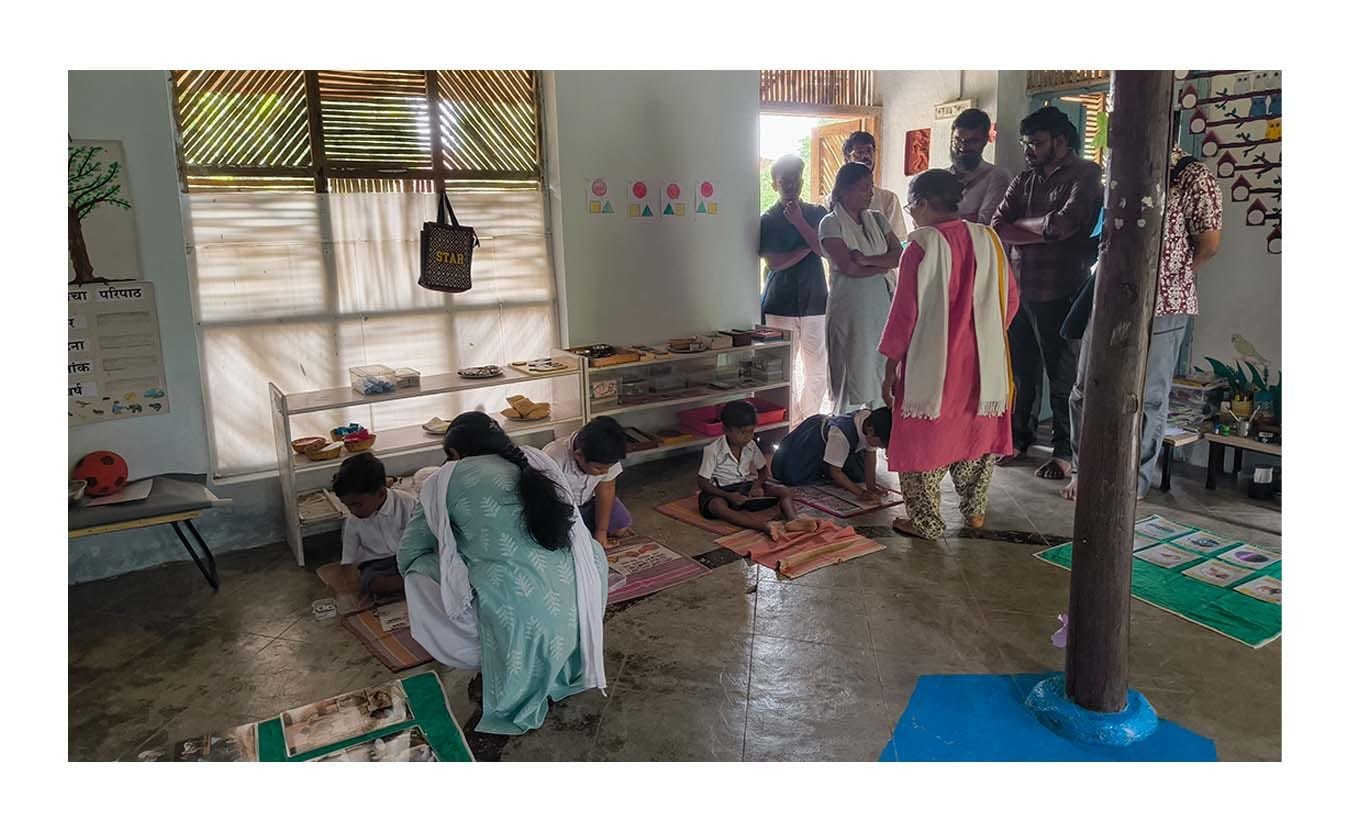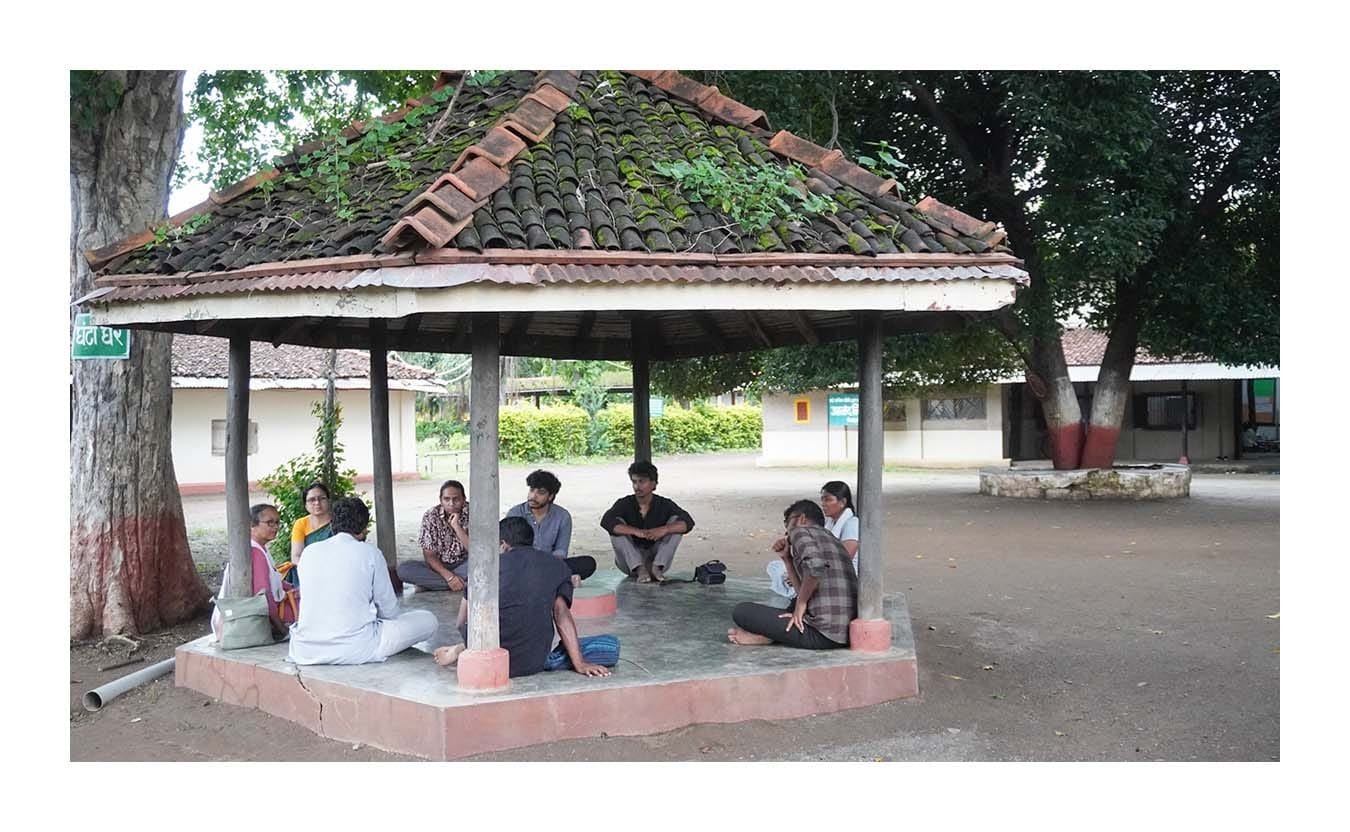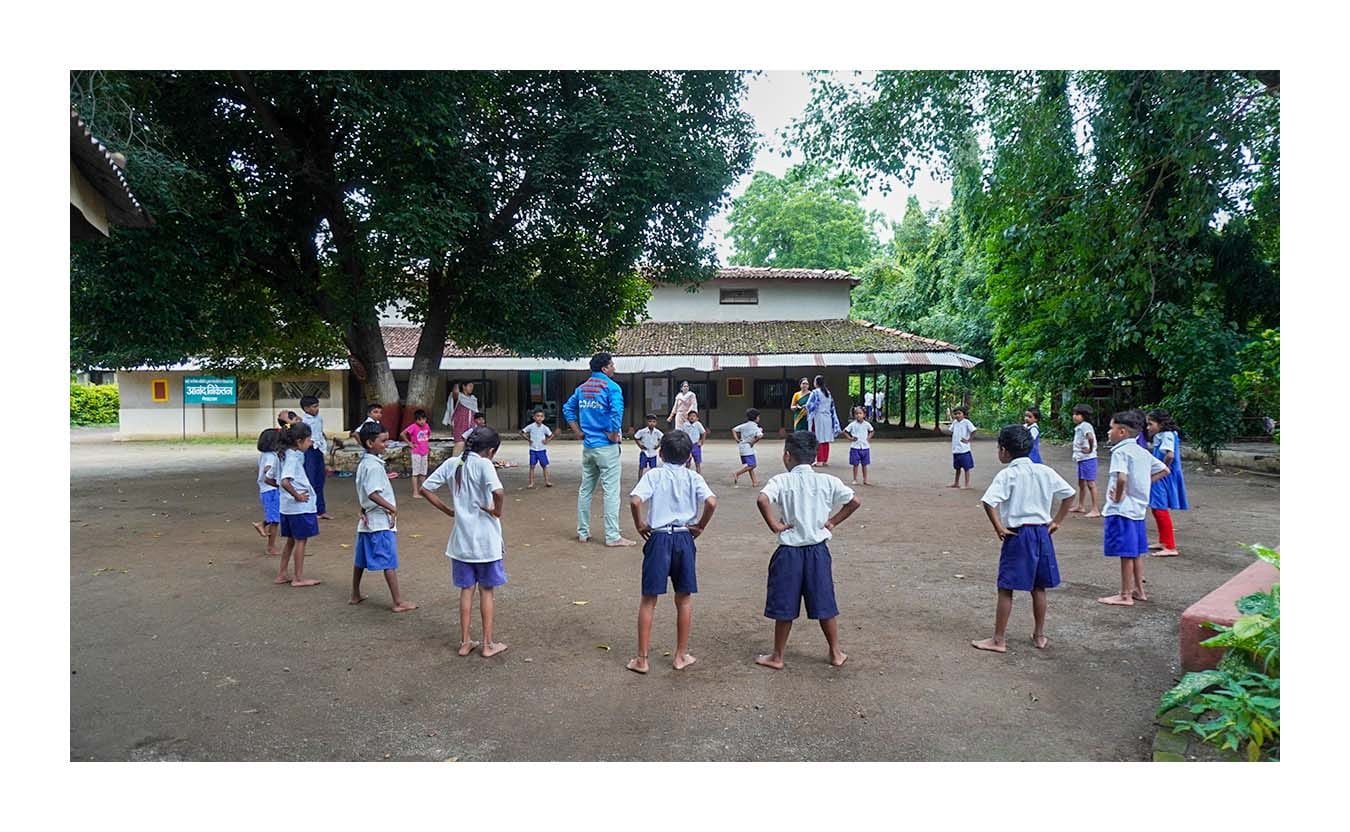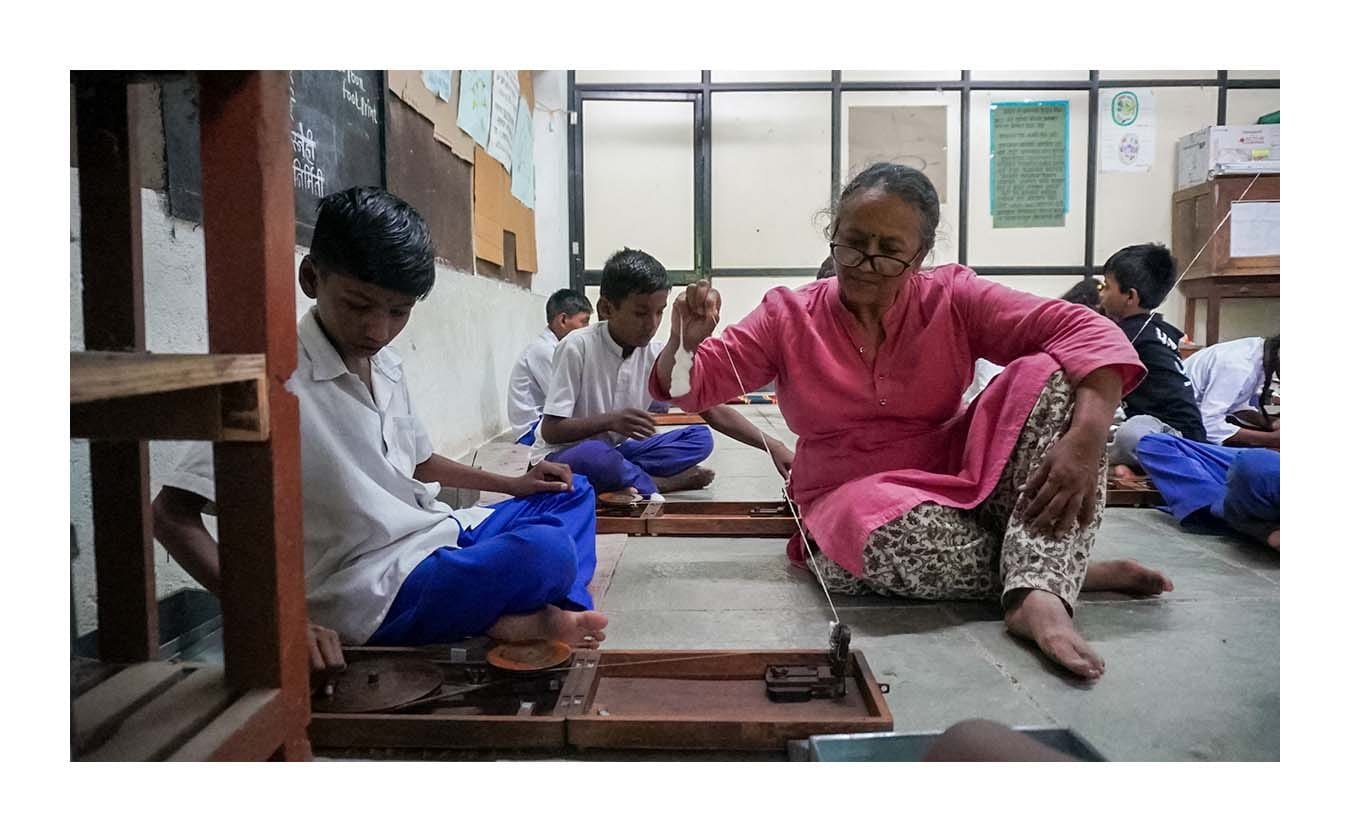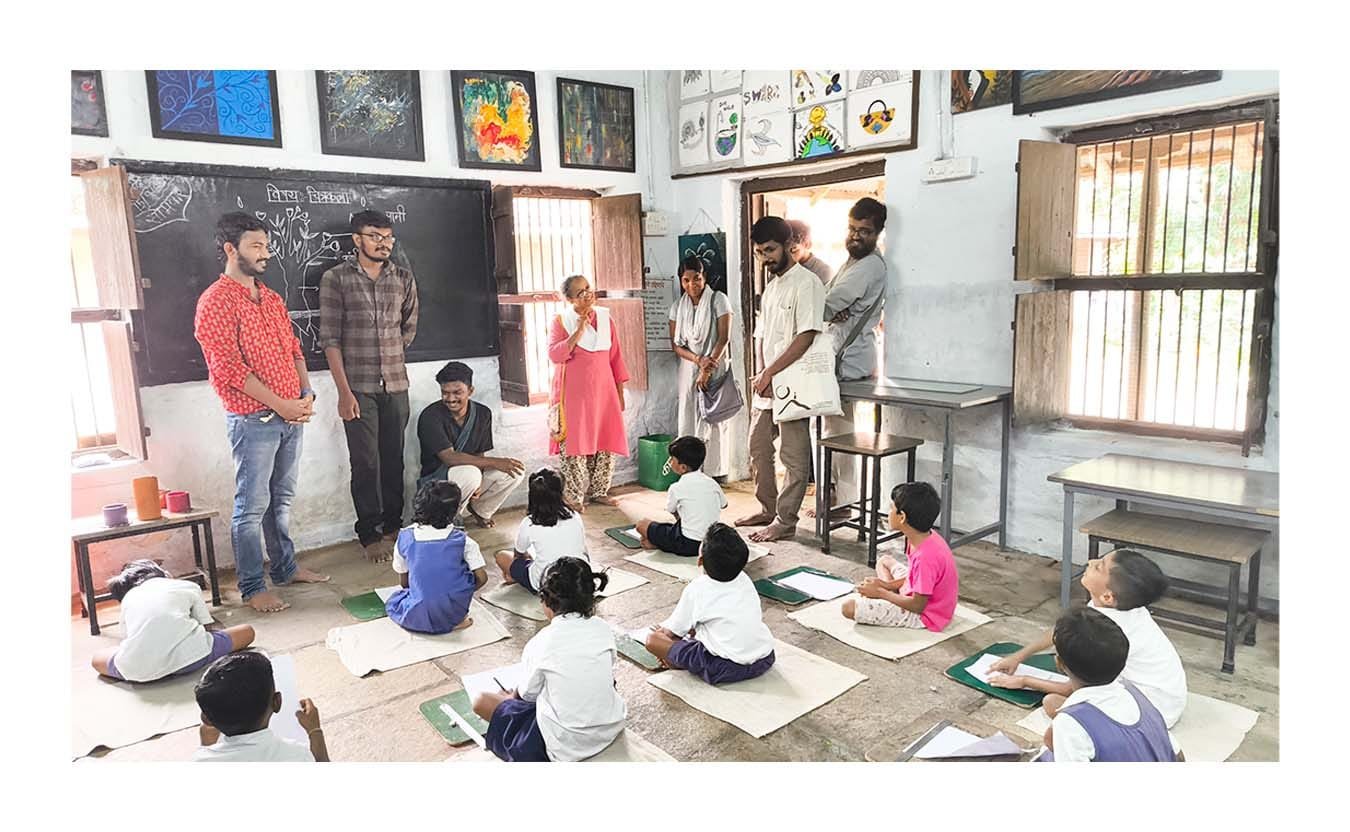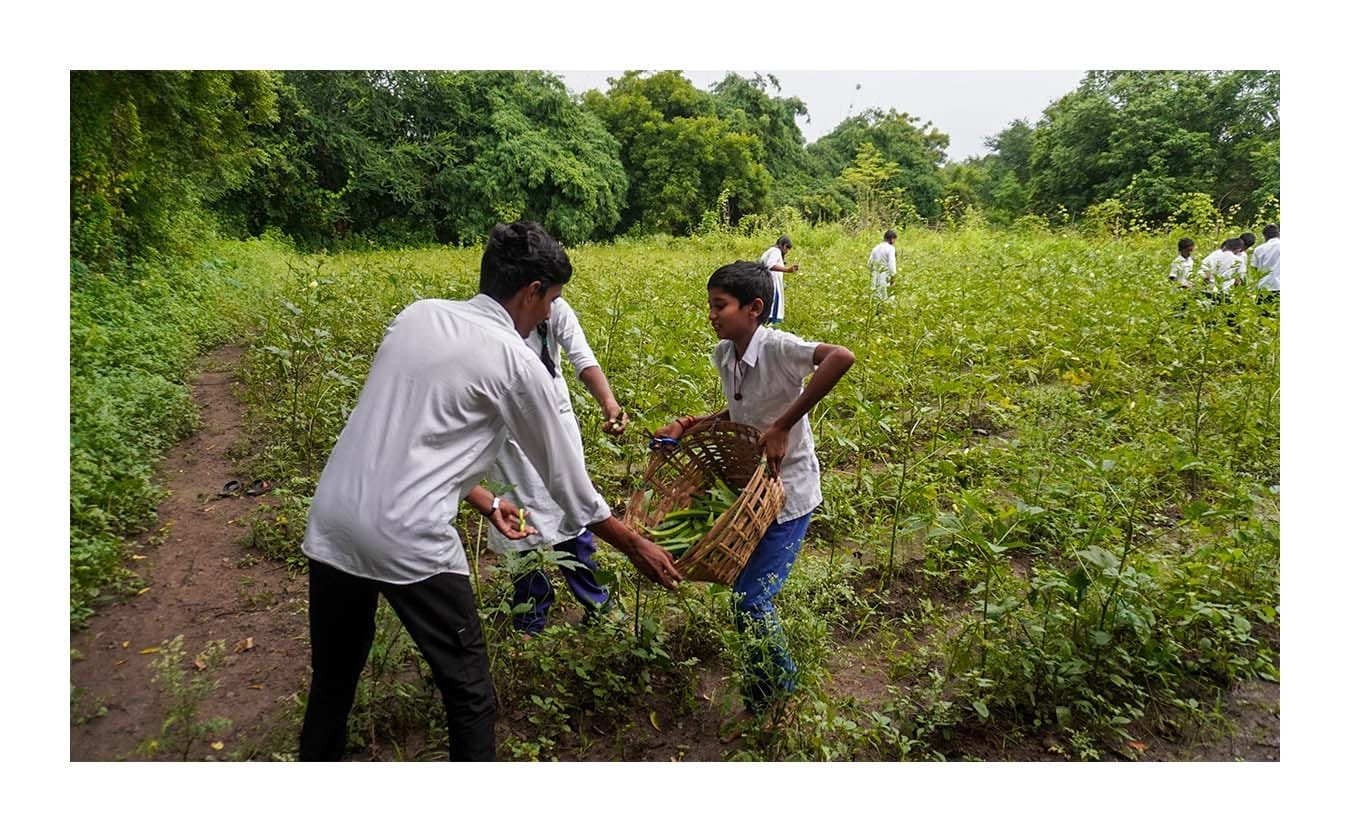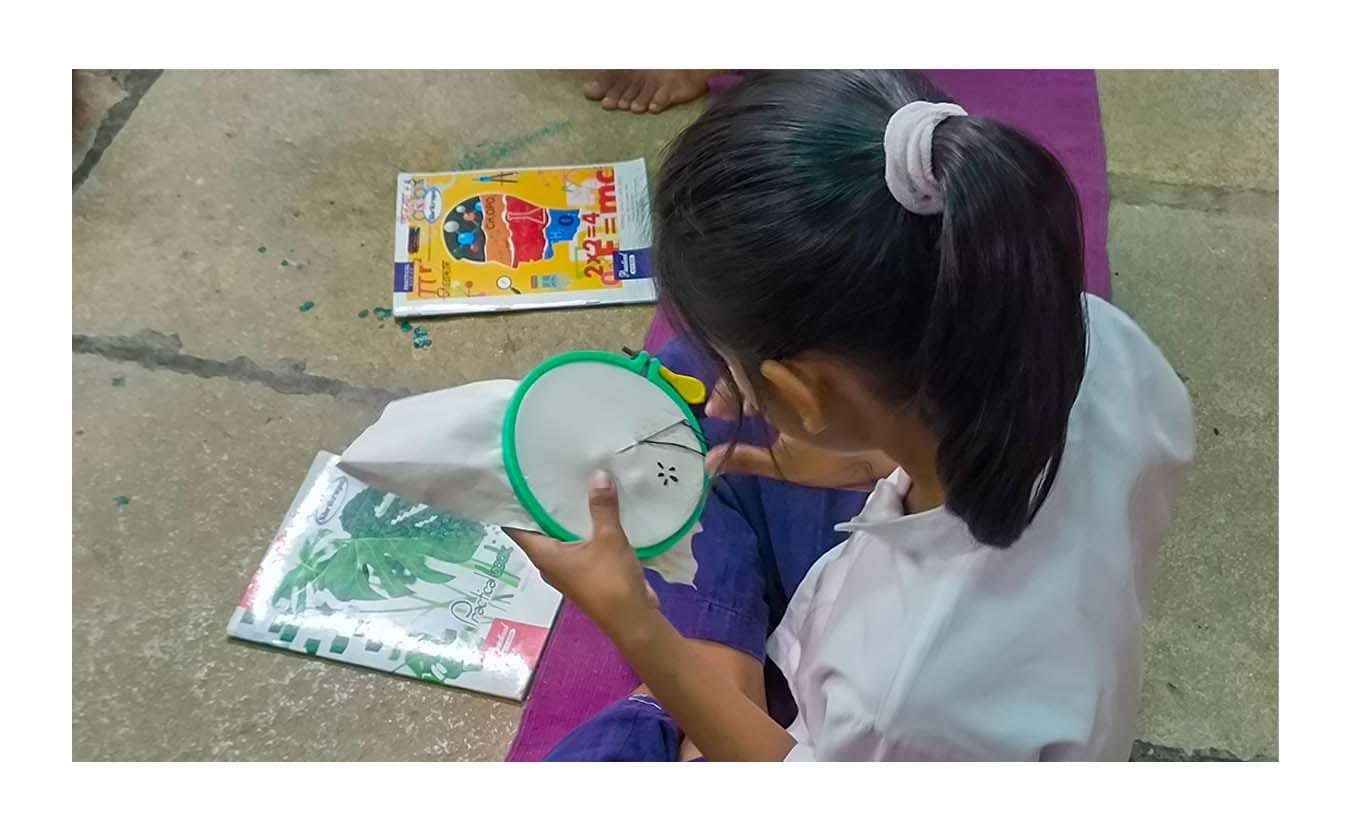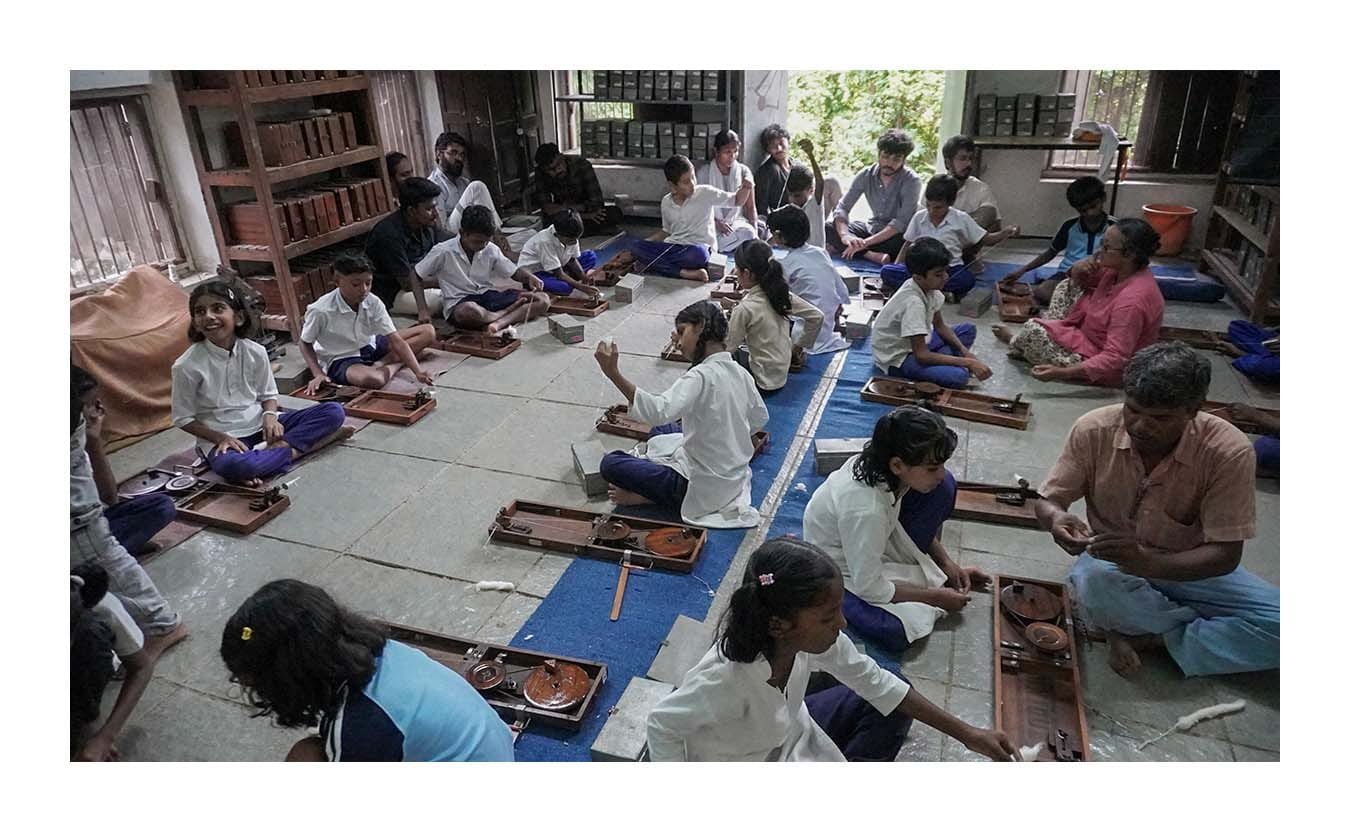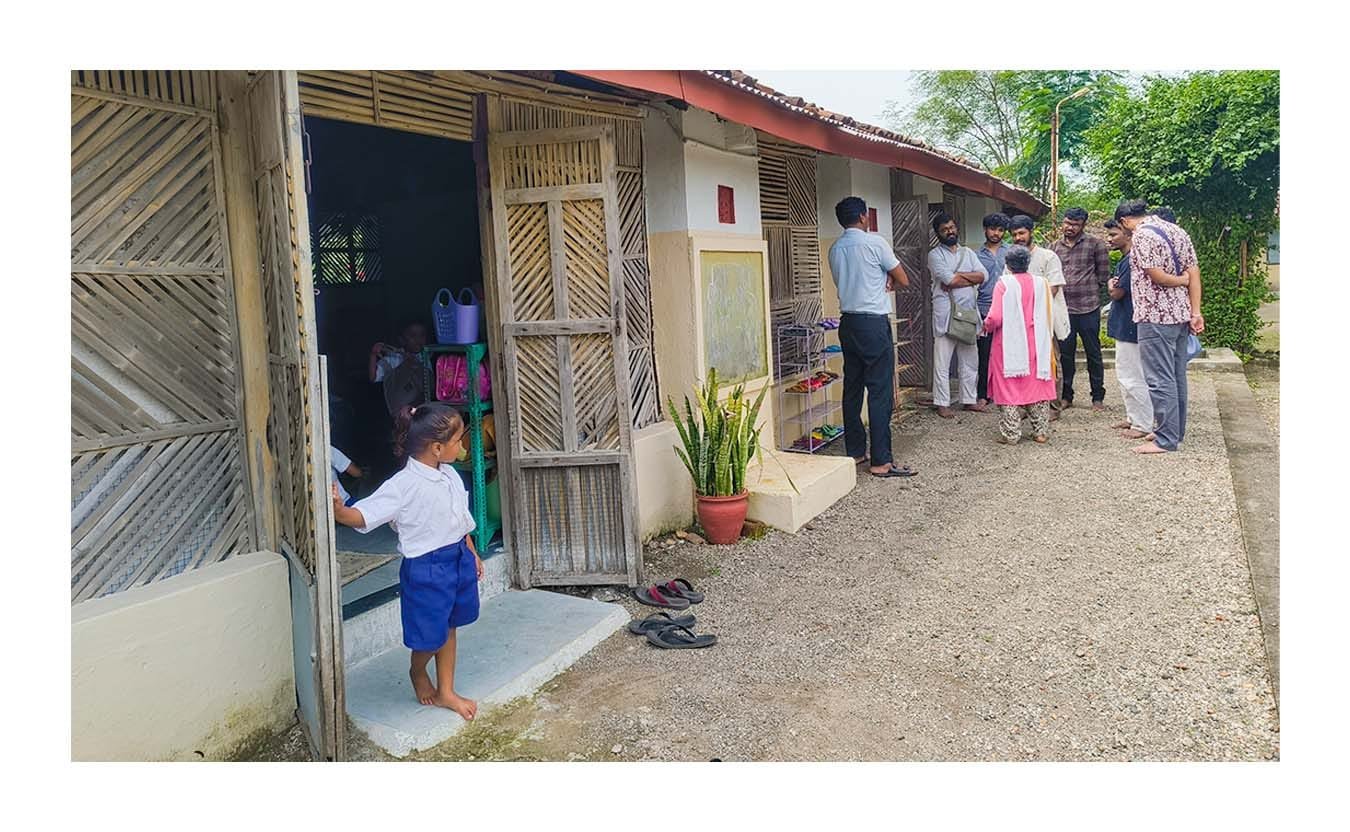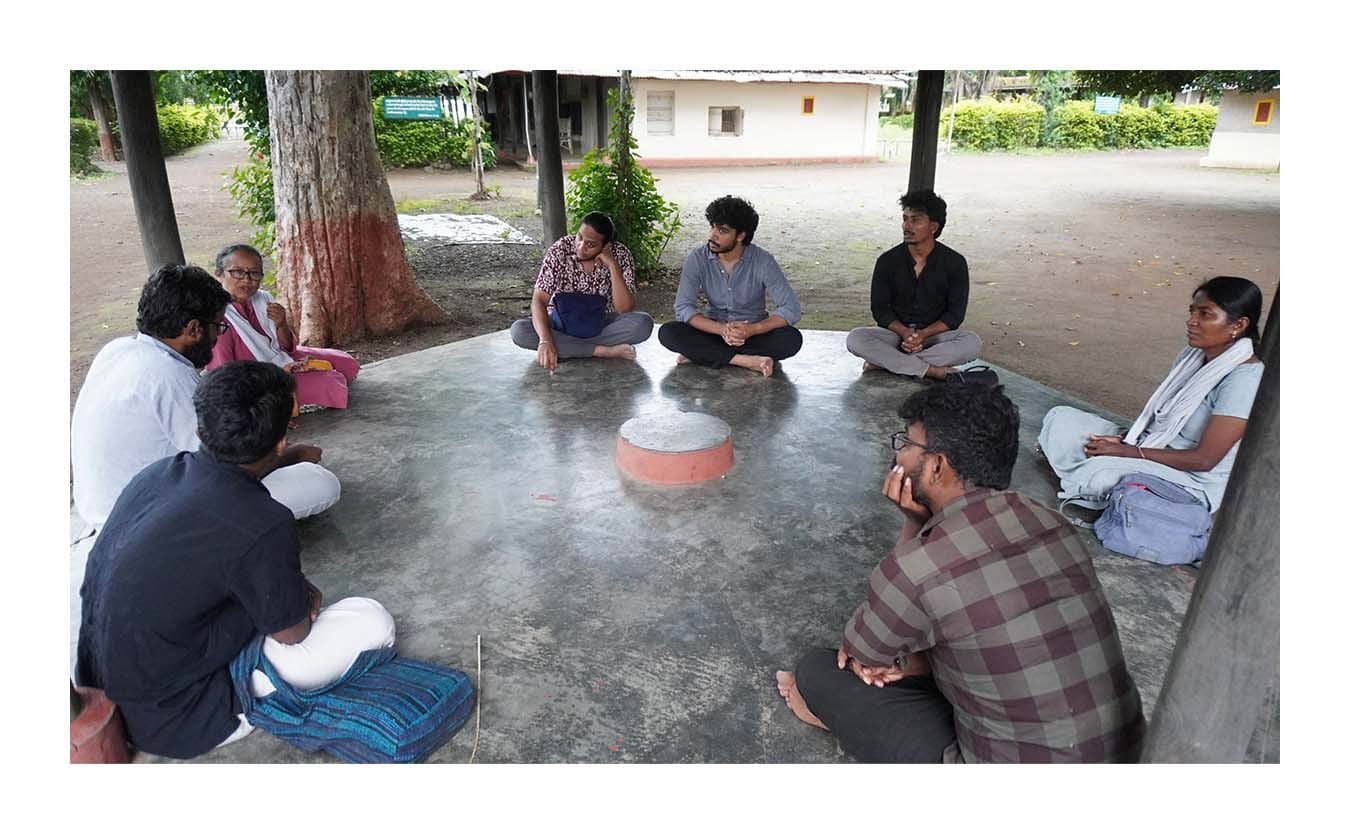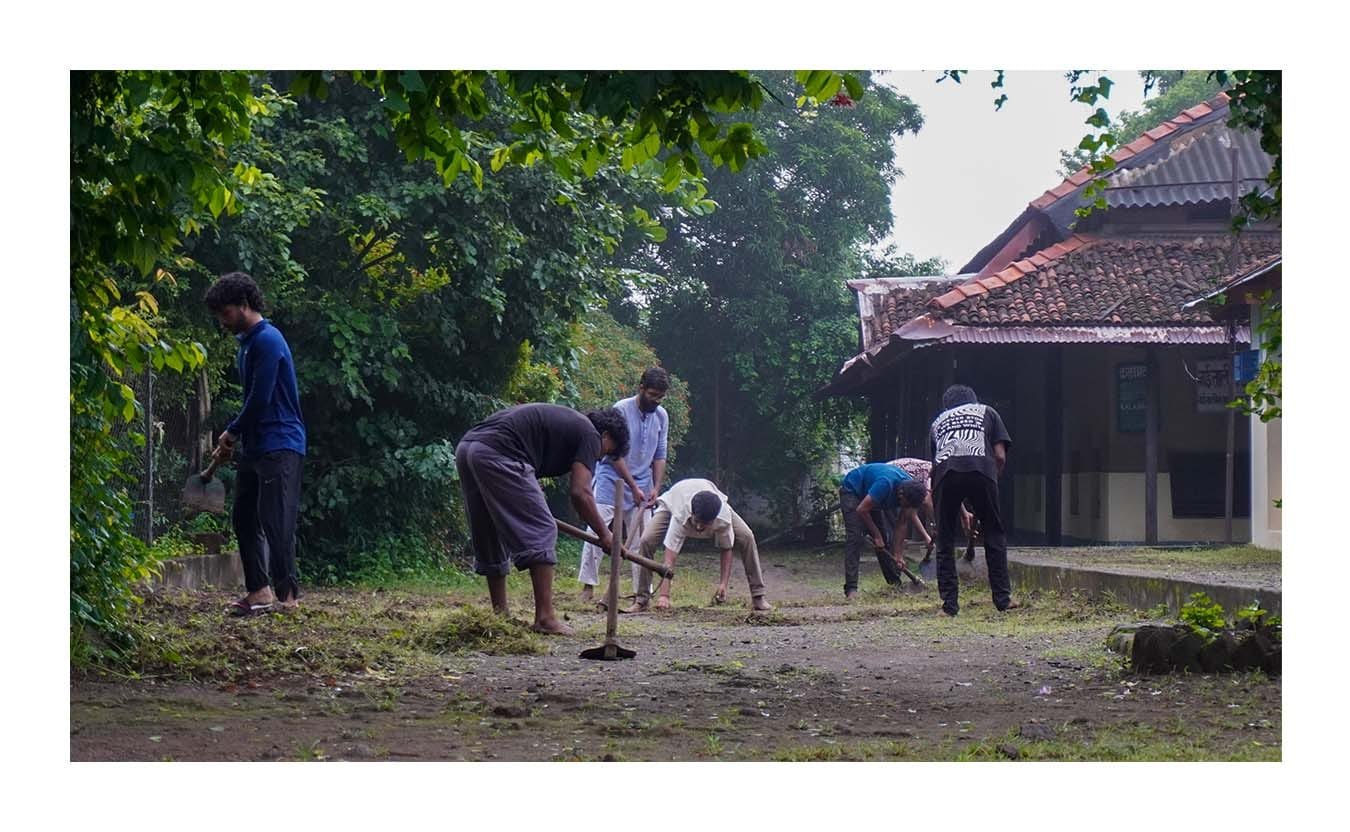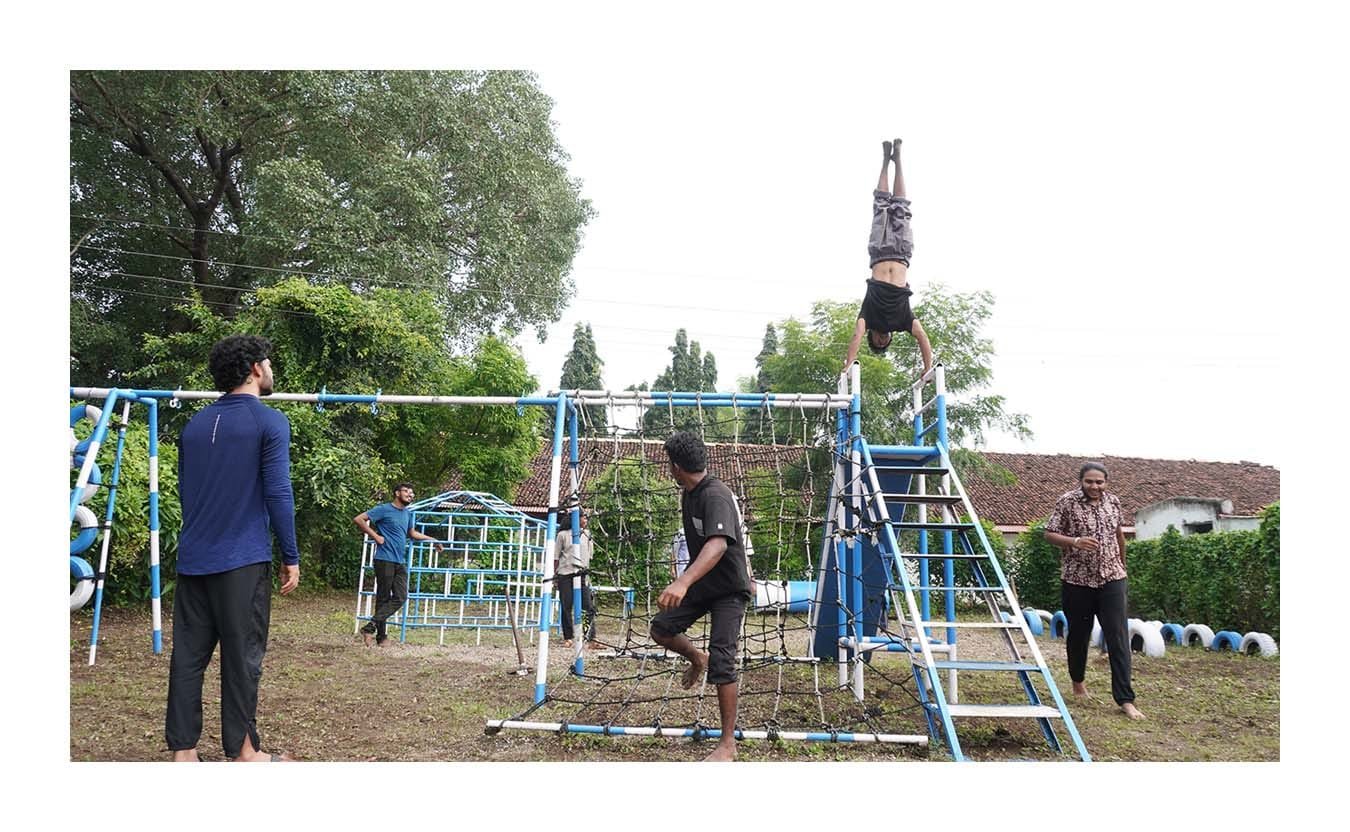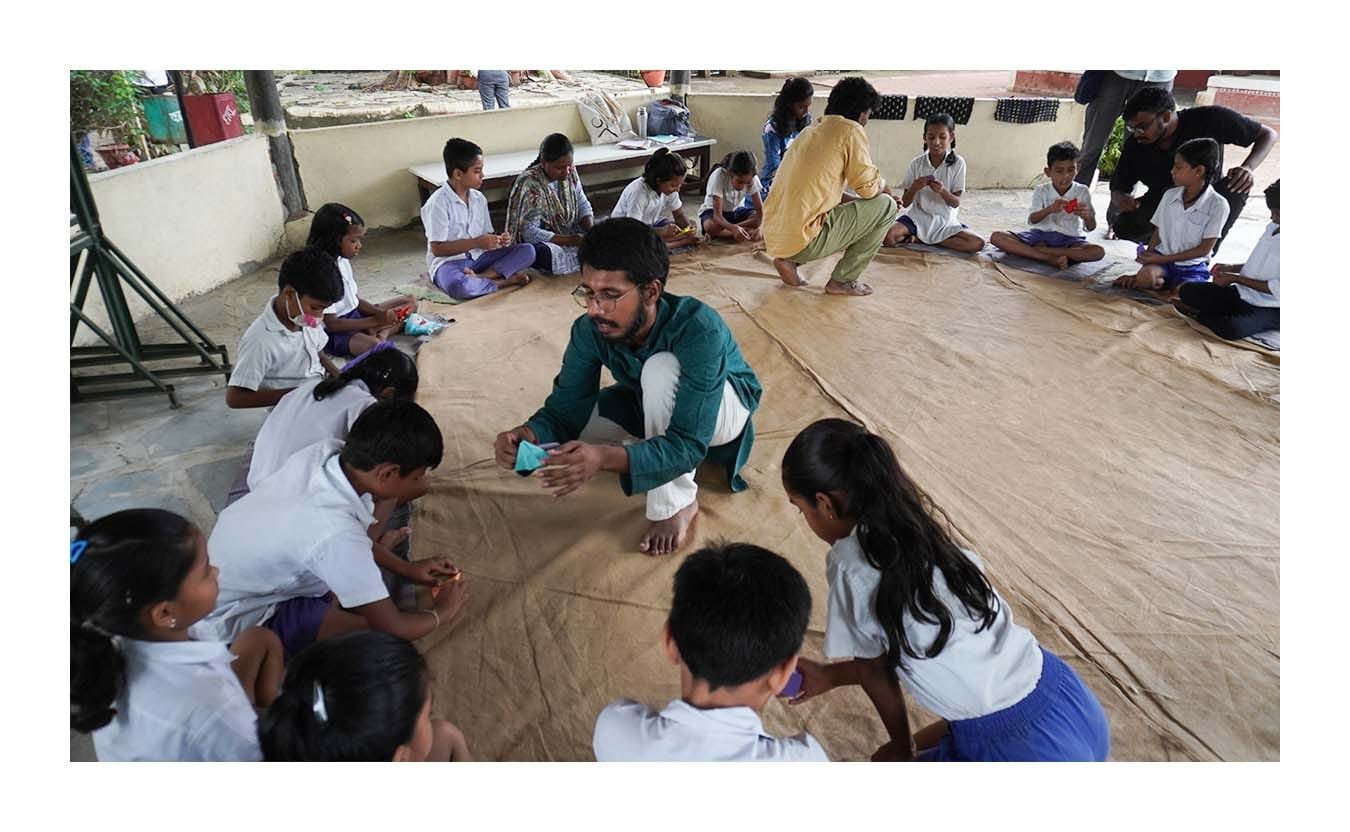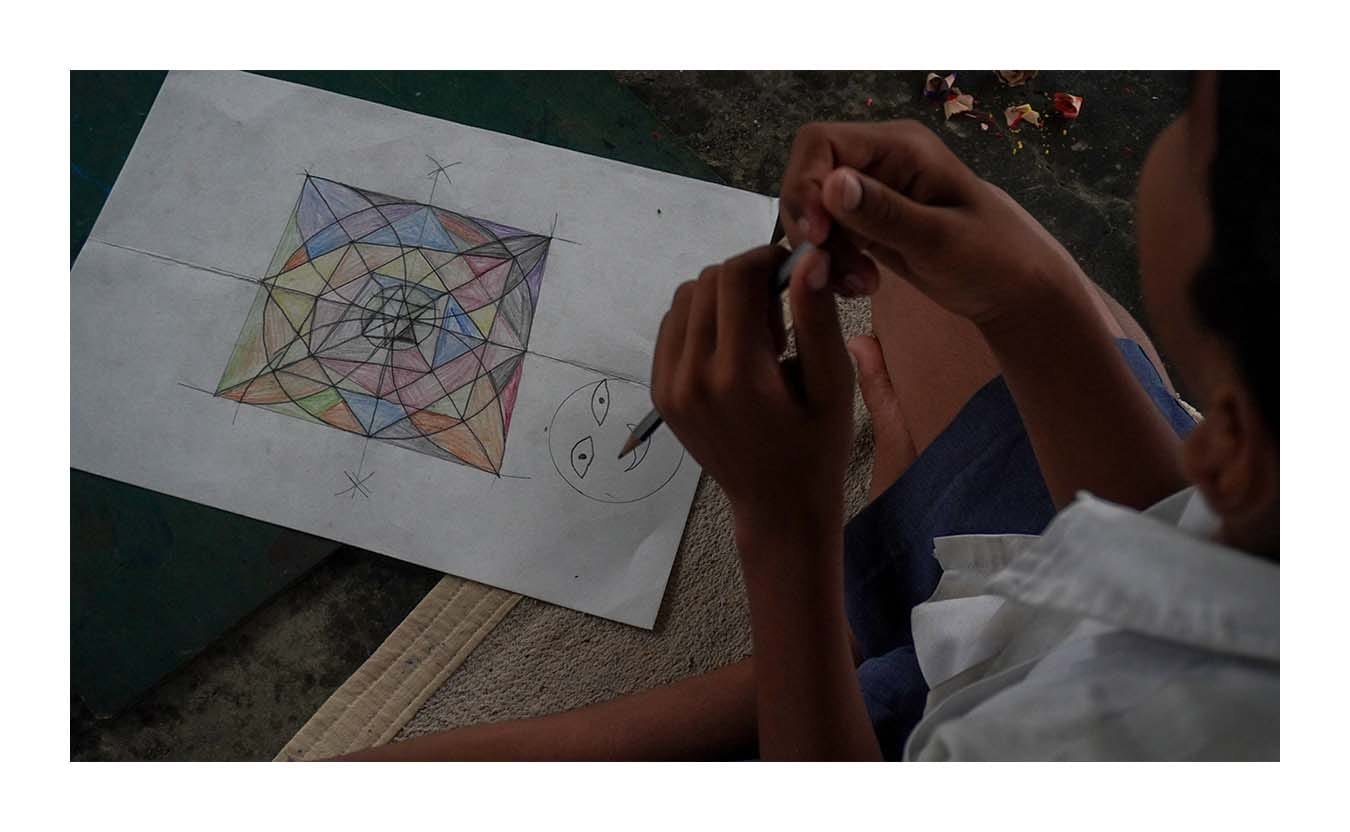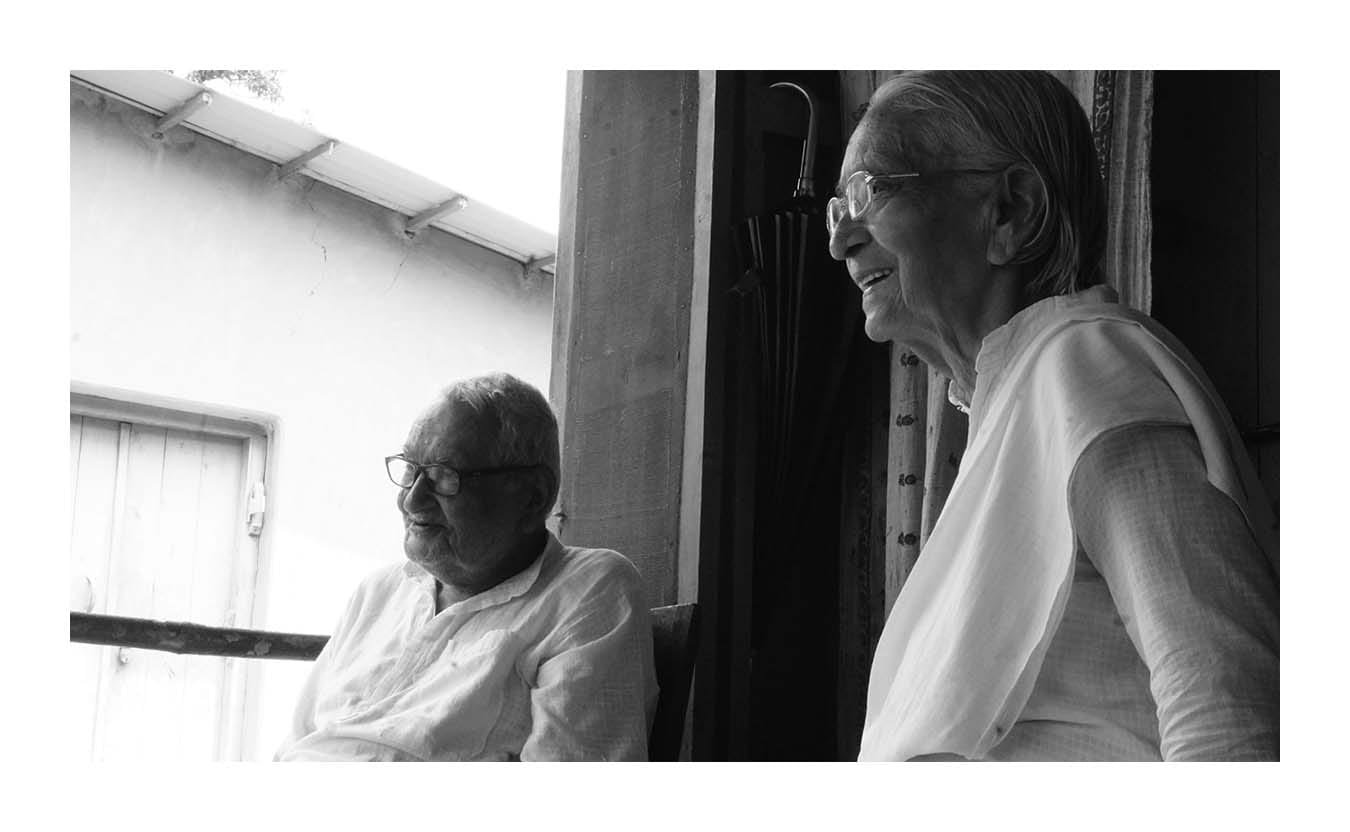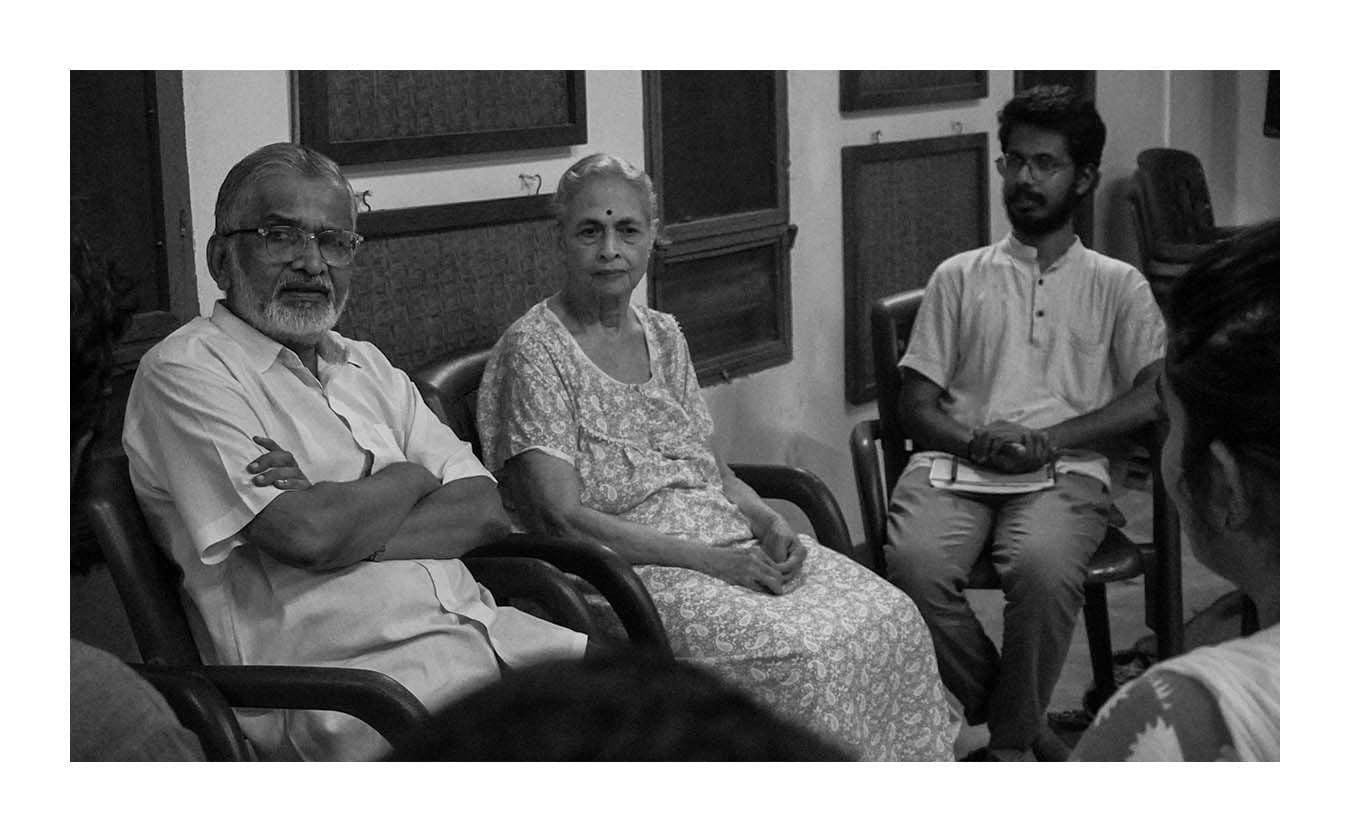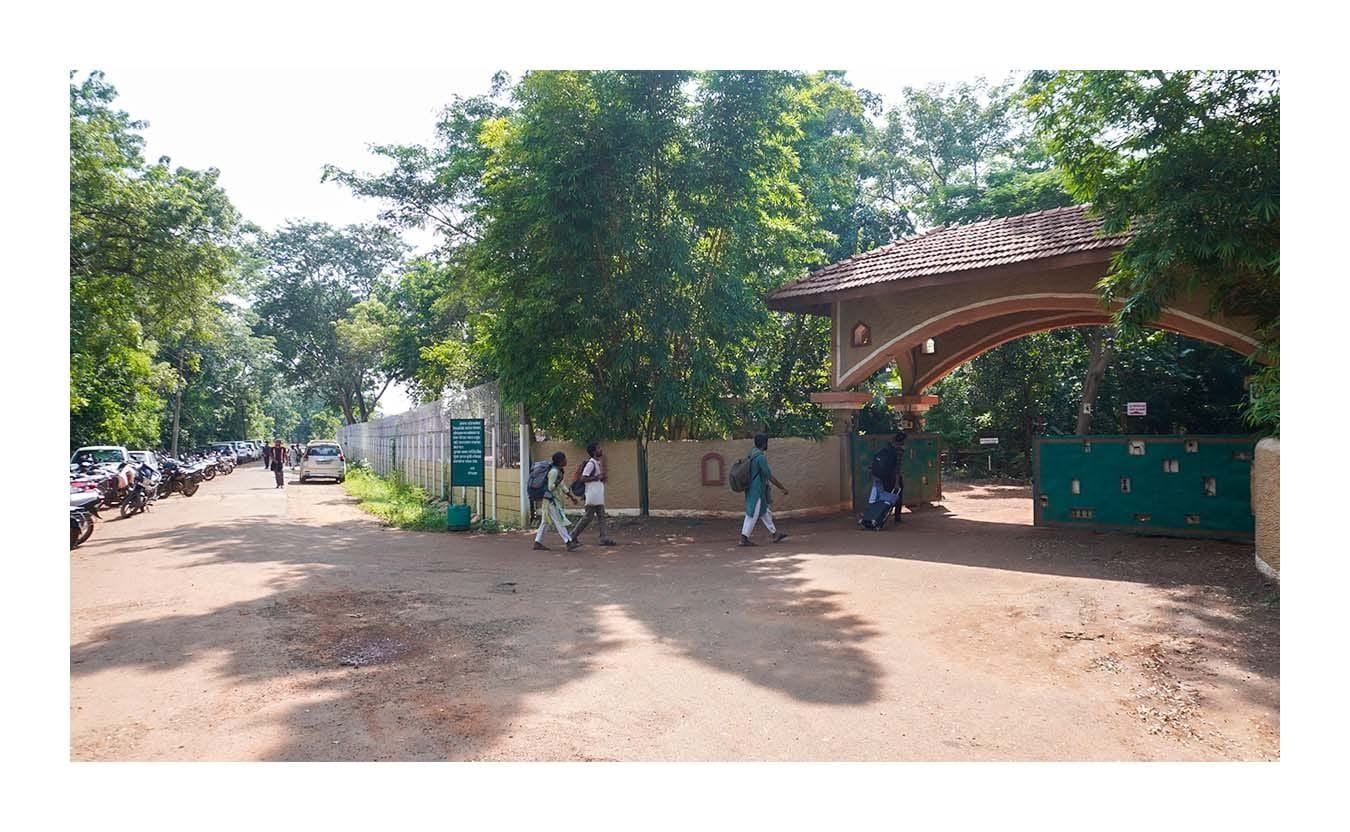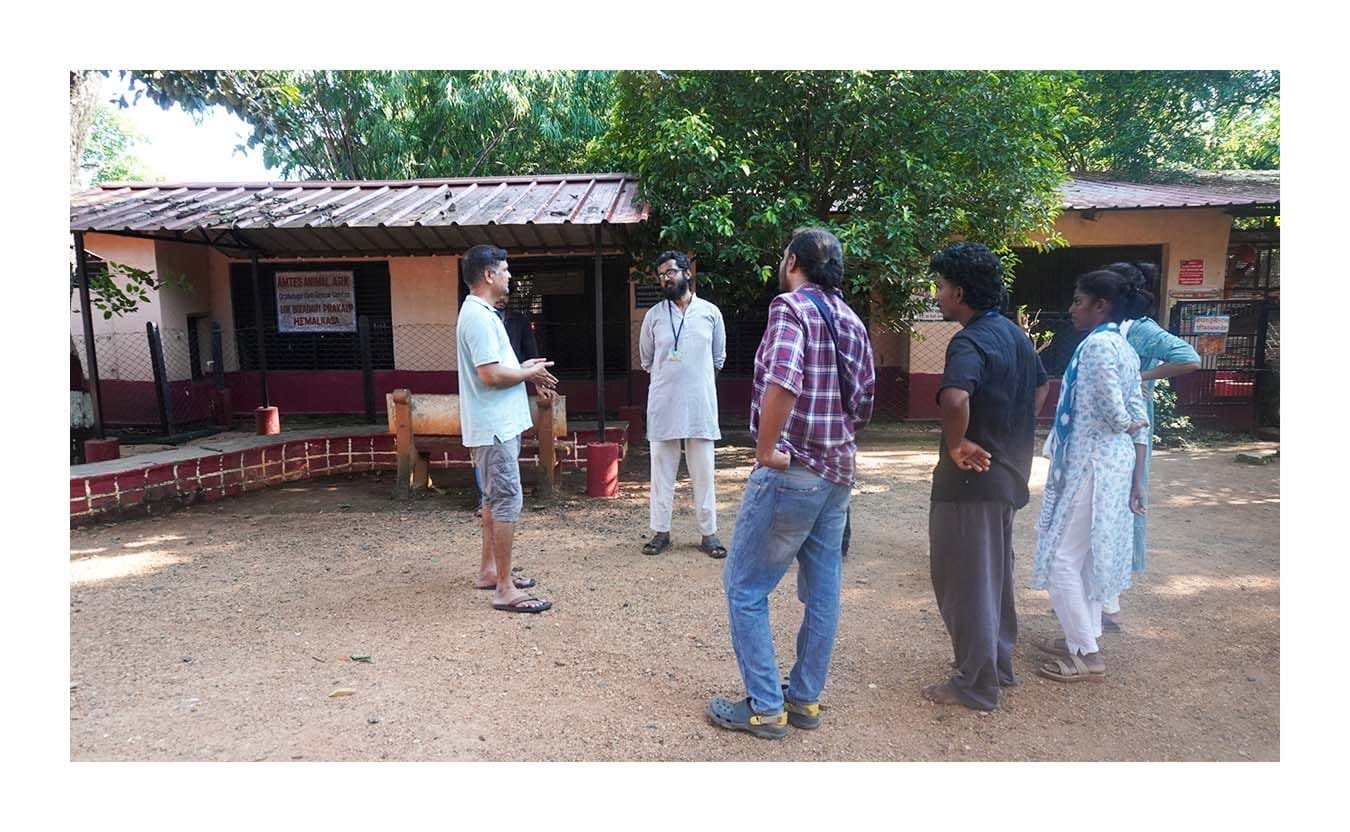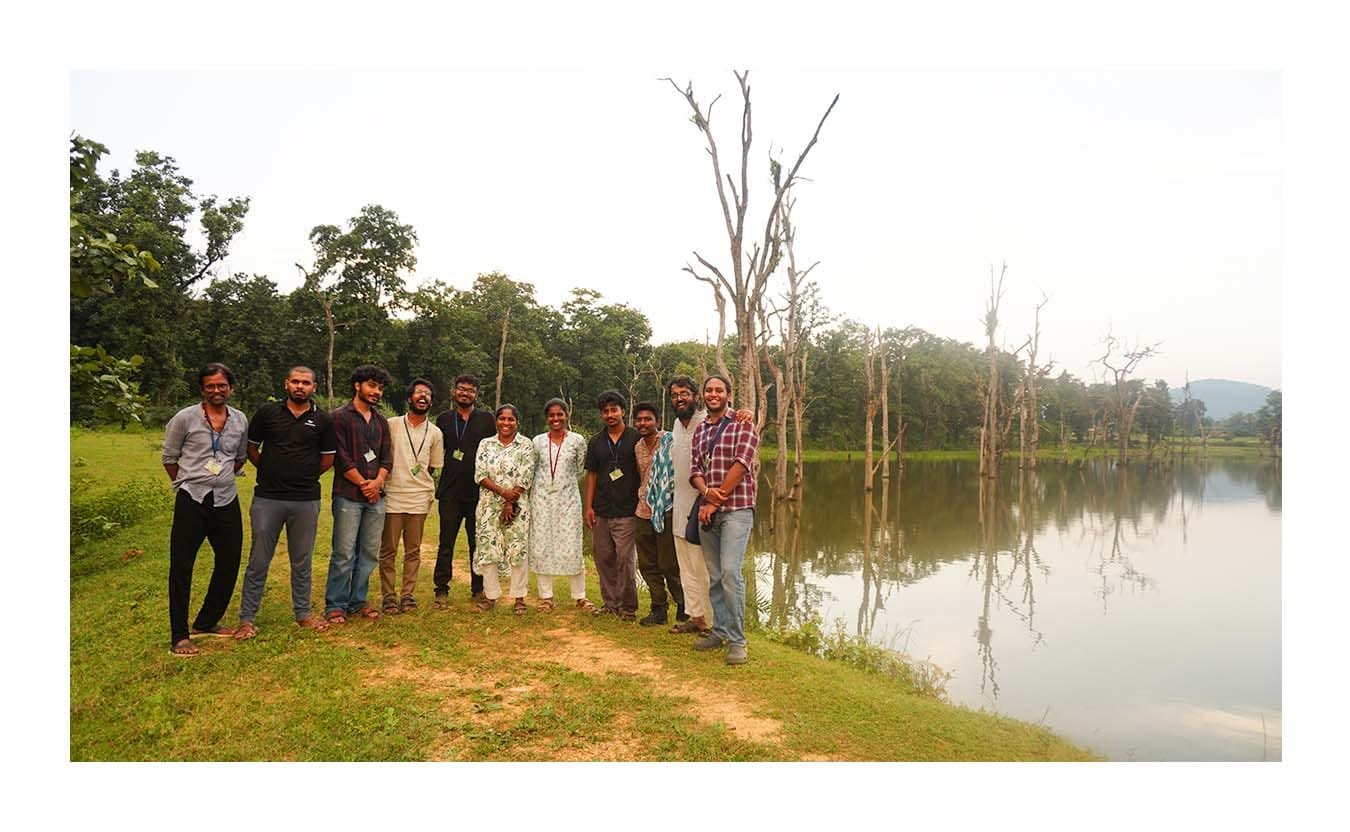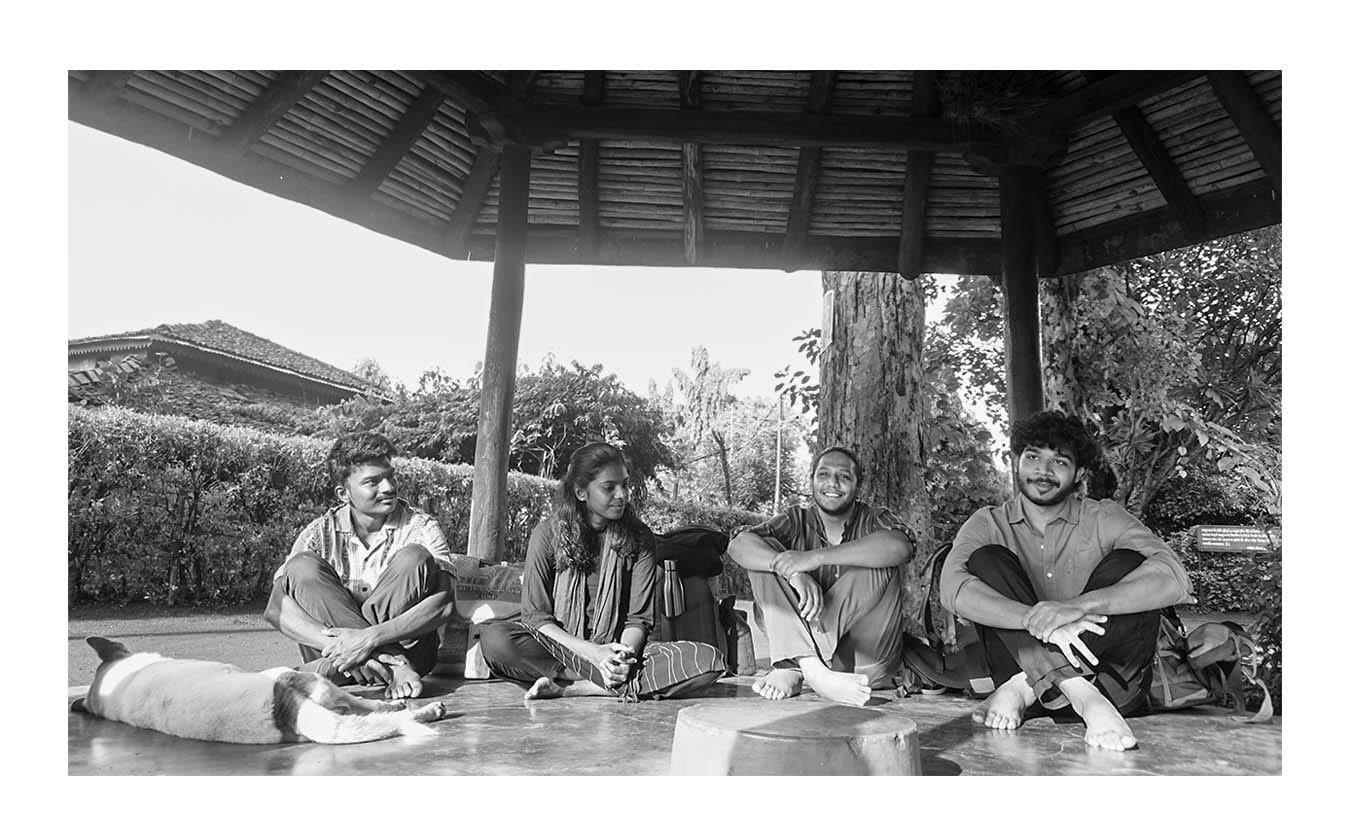“Have you ever felt hopeless about running such a non-conventional learning space for the past 25 years? And if yes, what made you continue to do it?” asked one of the participants of Niyathi to Sushma Thai, one of the oldest associated members of Naitalim.
She responded with tears in her eyes, “I have felt hopeless many times, but I bounce back because I cannot accept being defeated. I will keep working on Naitalim till I am physically able to. This is also a responsibility that has come upon me in this lifetime, and I will put in my 100% to the best of my capacity. As the present times are more complex in all aspects, it is essential that many youngsters are inspired to understand situations holistically and take up responsibilities to address them. There are many such small communities who are trying in their own ways to do this, and I am glad Cuckoo is one such space fostering youngsters through Niyathi.”
Later, after the conversation, Sushma Thai spent her entire day taking us around to all the spaces on the campus and explaining how the pedagogy is reflected in their learning process. We had the first-hand experience of observing children learning Math through farming of ladies-finger, Chemistry through cooking, Economics through upcycling tote bags, entrepreneurship through selling in the jatra and so on.
There was no hierarchy between students and teachers, but they were peer learners. Hence, there was no fear in the students but mutual respect. There was a sense of self-discipline and self-taught obedience without any control mechanism. It was also interesting to observe that neither the teachers nor the students were bothered by the presence of the principal in class. Rather, the students were very happy to share their works with the principal, as if they were talking to their friend.
















We were blessed with the opportunity of offering Shrama daan in Naitalim, adding our small contribution towards the history of the place. The participants also had a chance to share and co-learn origami, kalamkari, mandala and photography along with children.
Origami started with children sharing the story of Sadako Sasaki and the paper cranes. Kalamkari sharing started with the story of ‘the mountain that loved a bird’, and children joyfully created the joyous bird motif on fabric. Initially, one of the children who was practising mandala expressed that he did not like his mandala when drawn in pencil, but later started liking it when he colored it. After finishing his piece, he asked, “Didi, from which angle does my mandala look good?” as he kept rotating his drawing. Some children were also interested in using the camera and happily clicked a few pictures.
From a child who started crying even when one of the origami folds didn’t come out properly, to another child who taught other children mandala coloring, to another child teaching the participant about brush strokes in Kalamkari and to a child who gifted all the origami paper cranes that they did, the involvement and interactions taught the participants to understand various ways of responding and interacting with children, in the end becoming children themselves.
While there were various sharings during the reflection circle, one of the participants shared that he wishes to start a Naitalim school in his village. Summing up the impact of two days in Naitalim.















The next morning, before dawn, as we entered the premises of the Gandhi Ashram and were guided by the torchlight of an inmate to the verandah of Bapukuti, where the morning prayer happens. As we sat there, the silence of the dawn melted into the chanting of ‘Nam myoho renge kyo’, followed by prayers from all beliefs. One of the participants was blessed with the opportunity to sing ‘Vaishnava Jana to’ in Bapukuti, her voice becoming one with so many years of prayers lingering in space. The participants were later introduced to various daily morning practices for the body, mind, heart and intellect that would enable harmony in themselves. We later started on a silent walk towards Vinoba Bhave’s ashram towards Paunar. The walk gave the participants a lot of time and space to pause, self-introspect and reflect. The participants, through their experience of walking for 7 km, got a sense of why Vinoba Bhave, Gandhi, Baba Amte, Satish Kumar and many others chose walking as their mode of expression towards Sathyagrah.
“Didn’t Sivaraj and Stalin come with you this time?” asked 94-year-old Usha didi on arrival at the Paunar Ashram. We were astonished that all the Ashram inmates remembered their visit in all details, five years ago. We had an introductory circle with Gautam bhai, who had stories to share during his walk with Vinoba Bhave, about all the places where the participants were from. “I had gone abroad only once, and Richard Attenborough got to know that I was in London, and he had informed his secretary to arrange for a meeting with me. The next day, in the parliament house, the meeting was presided over by all top dignitaries dressed in well-made suits. I started my speech with two things: ‘One- I speak two languages – some broken English and Hindi, but you guys know only English. Two- while all of you can buy and wear any sophisticated clothing that you want, none of you would be able to buy what I am wearing because this has been completely hand-spun and hand-woven by me, and you can not buy this anywhere else.’ I got a standing ovation for a very long duration.”
Gautam bhai, through this story and a few others, explained to the participants the relevance of feeling confident about oneself, faced with any situation in life. One of the participants asked about his photographic journey, documenting the life of Vinoba Bhave, and Gautam bhai replied, “My mother gave me something in hand when I was thirteen and told me that it was a camera. That’s how it all started. I used to click and send her the reels? She developed it. Slowly, I got to know about cameras and the book ‘Vinoba Darshan’ is dedicated to the camera, as without it the book would not have been made possible”. “The sun was worried, one fine evening, on ‘what would happen to the world after sunset’, and had asked the Earth, Moon and others if they would be able to take up the responsibility of giving light to the world. But, all of them denied, and finally there was a voice that was heard from inside a hut, ‘I cannot give as much light as you, but definitely can light up this hut,’ replied a small mud lamp.” This story by Usha didi from Rabindranath Tagore’s poem left an everlasting impact on the participants, teaching them how to be confident and hopeful about their small actions.
Usha didi also spoke about the significance of consistently spending fifteen minutes every day on practices for the body, mind, heart and intellect. She also shared a lot of lessons from Vinoba Bhave’s life and the significance of not valuing or assessing oneself based on materialistic positions. We had an early dinner before sunset and finished the day with a sharing circle of the various activities in Cuckoo and the initiatives of individual participants.













The next day, after the morning prayer, the participants offered Shram daan in the goshala and left the ashram with a heartful of wisdom and a bagful of rotis.
After a long journey in the public buses of Maharashtra, we reached SEARCH – Society for Education, Action and Research in Community Health. We were welcomed by the shrine of Maa Danteshwari, the tribal goddess. “We are afraid of huge buildings and white coats. We neither understand their language nor are we allowed to stay with the family. How do you expect us to go there then?” asked the tribal women when enquired about not going for consultation to the government hospital. Understanding their perceptions, Dr Abhay Bang and Dr Rani Bang designed an inpatient ward resembling the huts of the tribals. The campus had a shrine to their local healing deity. The ward had space for a stay and a place to cook. The hospital on the campus was named after her by the tribal people as ‘Maa Danteshwari Dhawai Kaana’ in 1977. From the small hut to a multi-acre campus now, SEARCH has formulated various programs along with the tribals, truly making it a people-centric initiative. The timing of the mobile clinics is decided as per the people’s convenience and changes in accordance with the local harvesting cycles. We were taken around the campus and were introduced to their various spaces and their initiatives of the past fifty years.
This is probably the only place where the founders of the organisation, trained as professional doctors, meet with all staff members every evening for prayers, discuss spirituality, ethics and moral values, inspired by Gandhi and Vinoba. After the prayer, we were blessed to have a personal interaction with both of them. “What makes you believe in spirituality and surrender, over the scientific rational mind, especially when both of you are doctors, with master’s degrees from abroad?” asked a participant. Dr Abhay Bang replied, “It’s an important question but a difficult one. All human beings have a sense of ego, and the educational system keeps fueling it. It is difficult to completely get rid of it, and it was possible only by saints like Ramana Maharshi through the introspection of the self. That is why their words are still relevant even after a hundred years. But all of us, especially the youngsters, can slowly try and be aware of it through these two things. One is to take up some social work, working on the ground with people, which is bigger than oneself and dedicate oneself completely towards it. Two, is through complete surrender to the divine. And this sense of surrender is possible only through daily prayers and by imbibing the words of renowned spiritual masters. This is the reason why we have prayer every day.” Dr Rani Bang added, “There should also not be an ego from social work that you are doing something for the people. This sort of ego is much dangerous and poisonous. There should be no sense of ‘I’ in serving people. And always remember the idea of Daridra Narayana”.
Connecting back to the story said by Usha Didi, at Paunar, about the sunset, another participant asked, “What to do if the lamp from the light inside the hut flickers with heavy wind from the family and society? How does one protect the flame without being exhausted in such times of despair?” Both of them gave a pause for a minute, and Dr Abhay Bang replied, “In a few areas of Maharashtra, where it is windy, there’s a culture of having a small glass case around the lamp, so the flame is intact. Similarly, there should also be a protective cover around the flames that all of you are holding. This cover is the divine protection that comes through gratitude and surrender. And also, even if the outer flame exhausts, you should have an inner flame that keeps shining brighter every day. This is ideal, but definitely possible through consistent practices”.
Later, towards the end of the discussion, we gifted them with copies of ‘Inriya Gandhigal’, a book published by Thannaram about the people of today’s time following the Gandhian path, which had a chapter about both of them. This book was accompanied by the Tamil translation of ‘My Magical School’ by Dr Abhay Bang on his experiences of Naitalim. They also invited Eetrarai Myvizhi, who runs an initiative for pregnant women in villages to come back again for a longer stay, so they can share their experiences of working with pregnant women.








The next morning, we waited for more than two hours along with the local villagers staring at a never-ending empty road, anticipating the sound of a bus. This is when we realised how difficult it would have been to reach this place when they started about fifty years ago. After yet another long ride in the public transport, we reached the habitat of the ‘Madia gonds tribe’, deep inside the forest of Gadchiroli, where Lok Biradari Prakalp, established by the Amte’s family in 1973, is situated. The campus houses a hospital, a school for the tribal people and an animal rescue Centre.
In an evening walk, Dr Prakash Amte and Dr Mandakini Amte saw a set of tribal people carrying their food– a hunted monkey tied to a stick with an infant who was trying to breastfeed from its dead mother. When the tribals were asked, they explained that the baby monkey, along with red ant chutney, would be the food for the younger children back in their house. This realisation got the doctors thinking, and they wanted to save the infant at least. The doctors negotiated a barter system of taking the infant monkey and giving them rice in return to feed their children. The tribals agreed, and the monkey became the first orphaned rescue, joining their family. This slowly became a habit, and any orphan infant animal would be left with them, and this slowly developed into an animal rescue centre. The participants were taken around the centre explaining the story of how various animals, including hyena, fox, cheetah, crocodile, etc, arrived at the centre.
The school had a unique concept of having individual rooms for each of the subjects, where the teacher stayed in the same classroom and the students shifted for every period. The school also had a bank run by children. In the initial stages, the doctors used to go house by house to get children to the school, but the tribals feared for the safety of their children. After a year of perseverance, the school had about twenty-five children, and of those, ten dropped out. And by the next year, the fifteen students went along with the teachers to convince the others in the village to send their children to the school. This cycle continued, and today there are around six hundred and fifty students studying in the school. Now the situation has reversed, with people wanting to send their children, but there is only limited space available in the school.
In a conversation with Aniket and Sameeksha Amte, they expressed that patience, tolerance and acceptance of people are qualities that they have observed in Dr Prakash and Mandakini Amte, which the youngsters should definitely imbibe. This was followed by a visit to the nearby confluence of three rivers, where the participants had the time to reflect on the learnings of the past few days. They were also shocked to observe a water pipeline leading to a mining industry nearby, sucking out all the water and leaving the tribal habitat dry.





The day ended with sharing learning and memorable experiences of each participant. The participants started expressing gratitude for being able to meet great mentors at such a young age. They shared how they started to learn to accept the given situation beyond their comfort zones. A participant also expressed his thirst for having more experiences, especially failures, so he can learn and bounce back stronger. Another participant shared that it was their first time travelling in a local bus, standing amidst the crowd. Photographer Kumaran expressed that he would get his little daughter when she grows and show them all these places and meet all the mentors.
A few things in common that most participants shared as a learning from various mentors was to spend an hour everyday consistently to train the mind, body, intellect and the heart; to read a few pages of a book by a realised spiritual mentor; to be more patient and tolerant with everyone; to be hopeful that the lamp they are holding will always be protected. The session was concluded with the story of Nammalvar, where he explains about the people being of three types in comparison to a train. One can be the wooden log that stops the train, or the engine that leads all the coaches, or the coach that follows the engine wherever it goes. The engines might be noisy, dusty, greasy, smelly and dirty than the AC coaches, but the engine is the one which decides where the train will go.
Only one per cent of the population will be willing to be engines like that, and all the participants of Niyathi are such engines in the making.

